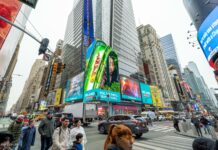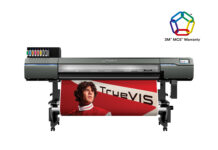Although vinyl is an important consideration, it’s really the art that’s the driving force behind vehicle wraps and what consumers notice. Because of this, shops should realize that the wrapping process starts at the design stage. “When a client wants to know ‘what it could look like’ and ‘what can you show me,’ the work starts right then,” says Dave Dorsey, president of Aurora Graphics (www.auroragraphics.net). “Hopefully this part is paid work, as this can be a very time-consuming proposition and no guarantee that the client will buy off on the design you created.
“If your artwork is dead-on, the client will close faster and close for more money, and you greatly reduce the ‘show and tell’ portion of the selling procedure, which happens on nearly every job that comes into a vinyl shop.”
Let’s check out three wrap specialists who are creating some dynamic, fantastic wraps for a variety of clients and check out how they “dreamed up” their design ideas.
Auto Trim Designs
J. Michael Thienal owns custom wrap specialist Auto Trim Design (www.autotrimdesign.net) in Appleton, Wisconsin. He uses Mutoh large format equipment to print onto 3M and Oracal vinyls at his 40,000-square foot location.
Thienal uses one word to describe an effective wrap design—“impact”—and he designs full and partial wraps around this philosophy. “Customers usually don’t know what they want,” he explains. “When a client tells us their desire and focus, things just ‘pop out’ at us. We’ll take snippets of information, after asking them what they want, and then develop a design we think will work for them.”
Thienal recently used elements from the Aurora Graphics library to wrap a Scion XB for the owner of nearby Muntz Audio Video. “We came up with the sub-woofer partial wrap on the side of the Scion,” he says. “The other elements—like the break-up—is actually transparent vinyl. It also has a tint to it, so the color of the vehicle shows through it partly.”
Thienal has also done work for area radio stations since the mid-1990s, since they have “more of a promotion budget” to work with wraps. For an alternative radio station in Green Bay, Wisconsin, Auto Trim wrapped a white truck with a red-background wrap and threw in buzzwords describing the station’s music philosophy. “We also grey-scaled their logo on the rear tunnel cover,” he says.
The important thing to remember: Wraps only last a certain amount of time. “As good as wrap art can be, there are always things that are going to pop up in certain areas or crack and scratch the vehicle,” says Thienal.
Pro DeZigns
Jim Wheat is the owner of wrap specialist Pro DeZigns (www.prodezigns.com) in Eldon, Missouri, and his shop caters to a mix of clientele—from commercial industries to small mom-and-pop businesses to larger chain stores. In four years, Wheat has expanded from a 2,400-square foot shop into a 9,000-square foot facility with lobby/offices, a print room (with a Mimaki JV-3 printer and a Royal Sovereign laminator), and installation area. (Note: Wheat prints his graphics onto 3M’s Controltac™ Graphic Film with Comply™ v3 Adhesive IJ180Cv3.)
Wheat believes that if a wrap is for company recognition or a marketing campaign, then the viewer should immediately notice the name of the business on the vehicle. “The company’s name needs to be very prominent. Then [viewers] can be impressed with the rest of the wrap,” he explains.
Recent wrap projects include box trucks for a nearby furniture store and an eighteen-wheeler gas tanker for a local propane company. Some out-of-the-ordinary jobs wraps include caskets and, yes, even a marine’s prosthetic leg.
Wheat begins each project by talking directly with the client in order to gain an understanding of the message they want to convey. When a drag car client wanted something that said “proud American” and “support our troops and country,” Wheat mixed-and-matched about six different files from the Aurora Graphics library to come up with a one-off, one-of-a-kind look featuring a U.S. eagle.
Since he works about fifteen miles from Lake of the Ozarks, Wheat has found “floating” success designing and installing wraps for boats. He recently completed a pirate-theme wrap for a forty-four-foot-long, multi-deck Carver yacht for Jolly Roger’s nightclub. “[The boat] looks like a wooden pirate ship, complete with cannon graphics and club logo,” he says.
There are unique challenges for designing boat wraps, mainly because of the shapes. “When you start designing and installing the graphics, you’ll find that the shape of the boat actually affects the material and makes things look like they aren’t straight,” he says.
Wizard Wraps
Alvin Barkeloo has been involved in the graphics industry since he graduated high school in 1989. His one-man operation Wizard Wraps (www.wizardwraps.com) fills a 3,500-square foot shop in Sunbury, Ohio. He uses a Mimaki JV-33 printer to output graphics onto 3M vinyl.
Barkeloo wrapped his own 2009 Honda Civic with some futuristic, science fiction-inspired graphics to let people know where he thinks vehicle wraps are headed. He managed this by combining individual elements from the Aurora Graphics library. “I duplicated one of the cyborgs and set them together,” explains Barkeloo. “The background is a separate element, and the wording is designed like cables shooting out at you.”
Barkeloo also completed a sharp-looking full wrap using Photoshop CS5 and Illustrator CS5 on a forty-five-foot-long Privo tour bus for Alexandra Cousteau’s Expedition Blue Planet series premiering soon on the National Geographic Channel. “The design features a water wave at the top and the series logo in the center that really draws your attention,” he says. “There’s also a nice wave effect in solid color positioned along the bottom part of the coach.”
Barkeloo believes that too much text can ruin a wrap design and, in turn, cause it to lose its effectiveness. “The design should be interesting enough that somebody would want to stop to look at the vehicle further from the initial five-second glance,” he explains.
Barkeloo also isn’t a big fan of simple, cartoony vector art designs with solid-white backgrounds. “I always want to do something that, when someone sees it, they know it’s a complete wrap on a vehicle,” he says.
For example, when Franklin Equipment, a distributor of rented agricultural and construction equipment, contacted Barkeloo requesting a new wrap design for their truck, he really unleashed his creative drive. The final design involves the company’s Superfan superhero mascot and a barricade along the truck bed that unzips (opens up) into grass and sky.
“I used the Aurora ‘cracked mud’ design to give the barricade a more rusty, hard look, instead of just a typical yellow-and-black design,” explains Barkeloo. “That artwork definitely doesn’t look boring.”









